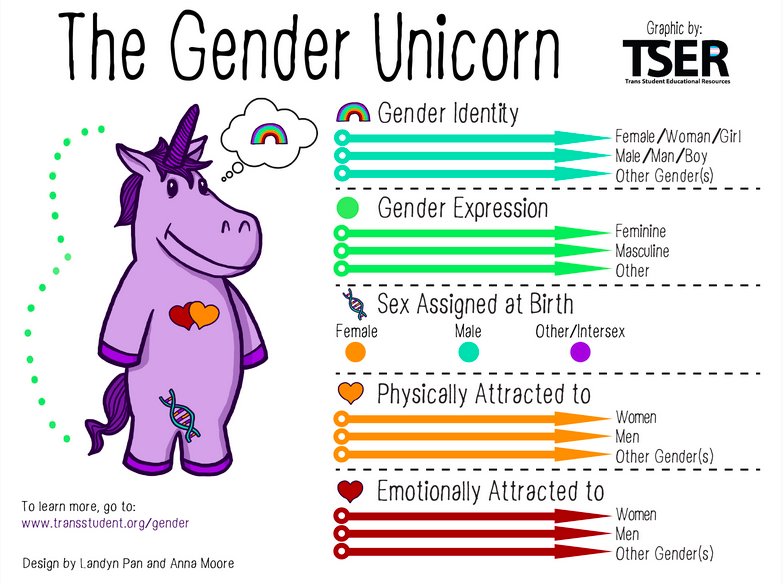 10
min
10
min

Sexuality, or sexual orientation, is a person's identity in relation to the gender or genders that they are typically attracted towards. Gender and sexuality are two different and sometimes related components of a person. Gender is largely personal- how we see and express ourselves. Sexual orientation is interpersonal- who we are or are not physically, emotionally and/or romantically attracted to. When gender is confused with sexual orientation, we can make incorrect assumptions about someone's identity.
Expand the drop downs below to learn about some sexual orientation terms. The terms people use to describe their sexual orientation are always evolving. The most important thing is to be respectful and use the term(s) that a person prefers.
Sexuality, similar to gender identity, is a part of someone's personhood. No one should ever feel like they
have to hide who they are.
However, many LGBTQ2+ people feel like they have to hide their identity or risk discrimination, as LGBTQ2+
people face violence and discrimination
at a higher rate than heterosexual people.
Hiding your sexuality and/or gender identity can be traumatic and painful.
The workplace is just one environment where discrimination can fester. LGBTQ2+ folks face discrimination in
many areas of their lives.
97% of workers have pretended to be heterosexual.
35% of LGBTQ2+ employees lie about their personal lives at work.
53% of LGBTQ2+ workers hide their sexual orientation in their workplace.
35% of LGBTQ2+ employees lie about their personal lives at work.
Concealing one’s sexual orientation at work reduces productivity by up to 30%.
(The Outlook Study, 2017) (Stonewall, 2008)

Let’s take a look at the Gender Unicorn again to explore and understand the definitions of sexual and romantic attraction.

Romantic attraction is often described as an emotional connection with someone.
Examples are:

Physical attraction is an erotic and sensual connection with someone.
Examples are:


Take 1 minute to reflect on each of these questions and note your answers down:
Similar to how people can have a different gender identity and expression, people can have different
physical and emotional attractions.
Take asexual people for example. People who are asexual feel emotional attraction to people, but not
physical attraction.
The language we use can respect someone's sexuality or contradict it.
LGBTQ2+ people already face discrimination and hardship. Using language that contradicts their
sexuality can cause further harm.
On the next slide, we will introduce some terms that infer someone's sexuality, and when used can contradict
someone's actual sexuality. Similar to gender, it is important to not assume you know someone's sexuality
unless they confirm it with you. Sexuality is not always appropriate to ask about.
We can use neutral language to avoid assuming what someone's sexuality is or forcing someone to reveal what
their sexuality is.
Instead of using...
Boyfriend/girlfriend
Husband/wife
Mother/father
Use this instead
Partner
Spouse
Parent
The following is one scenario and one statement. After the scenario and statement is presented, take a moment to think about out what is potentially harmful about it before moving forward with the next slide.
Ashley is a new hire at your company. You know nothing about Ashley other than that they are new. You
are speaking with
Ashley about the upcoming holiday party and ask them the question below.
“Hey Ashley, there is a holiday party at the office coming up. Everyone brings their plus one, will your
boyfriend be there too?”
In this situation, you knew nothing about Ashley other than that they are new to your workplace. In
the statement, you assumed Ashley is heterosexual and has a boyfriend. Sometimes we might
unintentionally assume someone's sexual orientation, but it is important to note that we could never
accurately guess someone's gender or sexual identity, and it is not always appropriate to ask.
This statement could be improved by using neutral language and adapting the question to,
"Are you bringing someone to the holiday party?" In this statement,
you are not forcing Ashley to reveal their sexuality.
David and Mathew have been friends for a few months. They generally speak about work and their shared interest in books. The two have never spoken about each other's romantic life, sexual orientation or gender identity.
David and Mathew were talking about their favourite childhood shows. Mathew then talks about his first crush on a Disney princess. He then asks David which Disney princess he had a crush on growing up.
By asking David what Disney princess he had a crush on, he assumes that Mathew is heterosexual and likes
women. You should never assume someone's sexual orientation, and sometimes it is not appropriate for you
to ask either. You can provide opportunities for someone to disclose their sexual identity if they choose
to.
This statement could be improved by using neutral language and adapting the question to, "My crush growing
up was Cinderella, did you have a childhood crush?" In this statement, Mathew is not assuming that David is
heterosexual and he provides David with the opportunity to simply answer no.
It is important to respect someone’s sexual orientation.
Attraction can be from a variety of factors including, but not limited to, gender identity, gender expression/presentation and gender assigned at birth.
It is important to understand how language affirms or disrespects someone’s sexual identity.